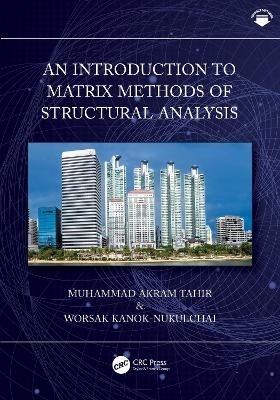
An Introduction to Matrix Methods of Structural Analysis
CRC Press (Verlag)
978-1-032-53202-8 (ISBN)
- Noch nicht erschienen (ca. Dezember 2024)
- Versandkostenfrei
- Auch auf Rechnung
- Artikel merken
The matrix force method has been systematically developed for the analysis of beam and frame structures. It helps develop the matrix stiffness method from a basic spring element, and this is extended to the analysis of beams, trusses, plain frames, grillages, and space frames.
Using computer programs (manual, automatic, or the direct force method extending toward automation), this book interactively introduces matrix methods of structural analysis. In addition to work and energy, it also discusses the concepts of stresses, strains, strain displacement relationship, and plain stress and strain.
Features:
Explains force, displacement, and stiffness via the matrix perspective.
Reviews full programming code for each problem.
Provides the modern concepts of force method that leads toward automation of the force method, such as the direct stiffness method.
Discusses effect of temperatures exclusively.
Includes the macro language Matrix Analysis Interpretive Language (MAIL) as an extension of analysis interpretive treatise with examples, exercises, PowerPoint slides, and illustrative problems. The MAIL executable, guide, and codes are provided on the website of the book.
This book is aimed at senior undergraduate and postgraduate students in structural engineering.
Muhammad Akram Tahir obtained his B.Sc. in Civil Engineering from University of Engineering and Technology (UET) Lahore. He obtained his Master and Doctoral Degrees in Structural Engineering from Asian Institute of Technology. Dr. Tahir enjoyed the patronage of Prof. Pisidhi Karasudhi, Prof. Worsak Kanok Nukulchai, Prof. Tamon Ueda, Prof. Martin Wieland, Prof. Gupta and many others who are authorities in structural engineering. Worsak Kanok-Nukulchai holds a Ph.D. from the University of California at Berkeley in 1978 under Fulbright Scholarship. He joined the Bangkok-based Asian Institute of Technology (AIT) in 1979, retired as AIT President in 2018 and is currently AIT Emeritus Professor. He returned from his retirement in 2019 to serve as the Founding Executive Director of a specially established Chulalongkorn School of Integrated Innovation (ScII) with unique curriculum to groom talents for the changing world of digital era. Professor Worsak was inducted into the Royal Society of Thailand’s Academy of Science in 2016, the AIT Hall of Fame in 2019 and Chulalongkorn Engineers Hall of Fame in 2022.
1.Matrix Presentation of Structural Quantities 2. Mathematics and Principles of Structural Modeling 3. Matrix Force Method 4. Direct Force Method 5. Matrix Displacement Method 6. Matrix Stiffness Method 7. Temperature Effects in Matrix Methods
| Erscheint lt. Verlag | 23.12.2024 |
|---|---|
| Zusatzinfo | 17 Tables, black and white; 404 Line drawings, black and white; 404 Illustrations, black and white |
| Verlagsort | London |
| Sprache | englisch |
| Maße | 178 x 254 mm |
| Themenwelt | Mathematik / Informatik ► Mathematik |
| Technik ► Bauwesen | |
| Technik ► Bergbau | |
| Technik ► Umwelttechnik / Biotechnologie | |
| ISBN-10 | 1-032-53202-5 / 1032532025 |
| ISBN-13 | 978-1-032-53202-8 / 9781032532028 |
| Zustand | Neuware |
| Haben Sie eine Frage zum Produkt? |
aus dem Bereich


